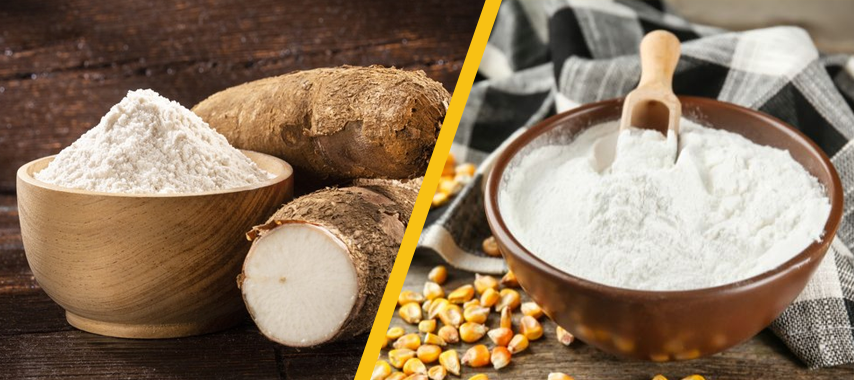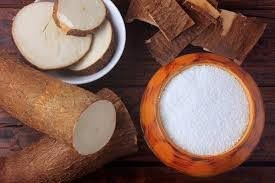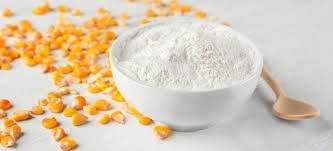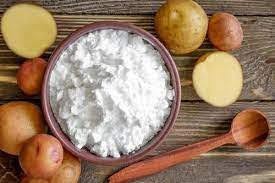

Published on Dec 18th, 2023

In the culinary world, starch is vital in many recipes as a thickening agent, binding agent, and significant energy source. Its adaptability can turn ordinary ingredients into outstanding dishes, adding depth, texture, and structure to the culinary palette. Among the wide range of starch alternatives, tapioca starch stands out due to its distinct qualities.
In the food business, starch is an essential thickening and binding agent. When heated with liquid, it experiences swelling and absorption, giving it a thicker consistency. Due to its specific characteristics, starch can be used in various baking and cooking applications, such as adding structure to baked goods or improving the thickness of soups and sauces. It is truly a necessary and versatile ingredient.
It can be intimidating to sort through the various starch options available for cooking. But worry not! This blog will examine several starches and their nutraceutical ingredients in more detail, including the differences between tapioca starch and other starches. We intend to provide you with knowledge so that selecting the appropriate starch is straightforward and well-informed.
A culinary treasure with an intriguing history, tapioca starch is carefully extracted from the cassava plant's roots.

The cassava roots must be thoroughly cleaned, peeled, and grated to produce tapioca starch. This detailed procedure aims to extract a rich, starchy juice from the roots. This liquid, rich in cassava essence, goes through a transformation process. It transforms into the fine, powdery texture that characterizes tapioca starch in our kitchens through an adequately planned drying procedure.
Corn starch is a versatile thickening ingredient that is commonly found in kitchens across the globe. It is derived from corn. A process that includes grinding, steeping, and separating, which makes it a versatile component for a variety of recipes. It's well recognized for giving food a glossy sheen, and it works wonders, thickening soups, sauces, and gravies to provide a velvety, opulent texture.

Corn starch is notably gluten-free and suitable for people on restricted diets. But it's important to remember that overcooking or exposure to acidic substances could reduce its effectiveness and affect how the cooked food turns out. Knowing the subtleties of corn starch allows home cooks to take full advantage of its potential.
Potato starch is a versatile culinary staple valued for its neutral flavor and wide range of applications. It is derived from potatoes. It is extracted by grating or crushing potatoes, then washing and drying the fine, powdery material.

Potato starch is an essential ingredient in gluten-free recipes due to its exceptional texture-enhancing abilities, particularly in baking, where it produces soft, moist results. Its strong gelling and binding qualities enable it to achieve the proper consistencies in various recipes, and its ability to hold up with high temperatures makes it a perfect thickening agent for cooking for extended periods.
Derived from the rhizomes of the Maranta arundinacea plant, arrowroot is a highly valued natural starch renowned for its versatility in the kitchen. Arrowroot starch, extracted by washing, crushing, and drying, has a flavor that complements food flavors without overpowering them. It's an excellent option for translucent sauces and dishes with citrus or vinegar components because of its unique clarity and resilience in acidic environments. Those with food sensitivity will find arrowroot intriguing because it is readily digested and gluten-free.
Tapioca Starch: Distinguished by its tasteless nature, tapioca starch gives food a clean, silky texture without substantially changing flavor.
Corn Starch: Like tapioca starch, it has no taste and is known for leaving a glossy surface, but it can give food a somewhat hazy look.
Tapioca Starch: Tapioca starch is a reliable option for recipes that contain citrus or acidic ingredients because it is resistant to cutting elements.
Corn Starch: Corn starch's ability to thicken food may be compromised by extended heating or exposure to acidic substances.
Tapioca starch: Retains its texture and thickening qualities even after being frozen and thawed, demonstrating exceptional freeze-thaw stability.
Corn starch: Following the freeze-thaw cycle, it may become a little runny or lose part of its thickening properties.
Tapioca starch: Adaptable for thickening sauces and making crispy coats for fried foods, it may be used in savory and sweet recipes.
Corn starch: Often used to thicken sauces and gravies, it's well-known for helping achieve a smooth cooking consistency.
Tapioca Starch: Inherently gluten-free, this is a good choice for people with gluten sensitivity.
Corn starch: Another gluten-free option for people with gluten-related dietary concerns.
Tapioca starch: Defined by its tasteless nature, it gives food a silky, glossy finish. Ideal for producing outcomes that are transparent and clear.
Potato Starch: This starchy ingredient is excellent for baking since it produces soft, moist baked goods with a neutral flavor and a light, fluffy texture.
Tapioca starch: Prized for its ability to give baked items a light, airy texture and for being gluten-free. They are usually used in recipes without gluten.
Potato starch: Similarly valued in gluten-free baking, it helps replicate the crumbs and structures of conventional baked goods.
Tapioca starch: is resistant to acidic environments, making it a good choice for recipes that include citrus or other acidic ingredients.
Potato starch: Its ability to thicken may be affected by very acidic conditions since it may become less stable.
Tapioca starch: Suitable for culinary applications, it retains its integrity at high temperatures.
Potato starch: This starch's ability to tolerate high temperatures makes it a beneficial thickening agent.
Tapioca Starch: Distinguished by its flavorless taste, tapioca starch works wonders as a thickening agent without adding any flavor to food. It gives soups and sauces a transparent, velvety texture.
Arrowroot Starch: Having a similarly neutral taste, arrowroot starch is prized for its transparency, which gives food a shiny appearance. It works well in applications where one wants transparency.
Tapioca starch: In some cooking situations, tapioca starch can be advantageous because of its greater gelatinization temperature, which means it requires slightly higher temperatures to thicken.
Arrowroot Starch: This thickens at lower temperatures and has a lower gelatinization temperature, making it appropriate for recipes that call for mild and speedy thickening.
Tapioca Starch: Tapioca starch is a dependable option for a range of recipes since it is resistant to acidic components and keeps its thickening qualities even when it comes into contact with citrus or vinegar.
Arrowroot Starch: Tapioca and arrowroot starch both withstand acidic environments and provide a steady thickening in meals containing acidic ingredients.
There are many different types of starches worldwide, and each has unique qualities that suit customer tastes and intended uses. Among all of the starch alternatives, tapioca starch is a notable competitor.
The unique characteristics of tapioca stand out as clear benefits when comparing it to other starches. Its cassava root origin distinguishes it from other starch alternatives like cornflour and potato starch by ensuring a gluten-free choice and making it resilient in acidic environments. Tapioca is an excellent option because of its clear and silky texture, stability during freezing and thawing, and adaptability to various culinary uses.
Organic Tapioca Starch with its unique characteristics, should be investigated and contrasted with other starches. Customers who are aware of these distinctions will be informed to make decisions that align with their unique gut requirements and preferences tastes.
BackBe the first to know about new products, events and offers.